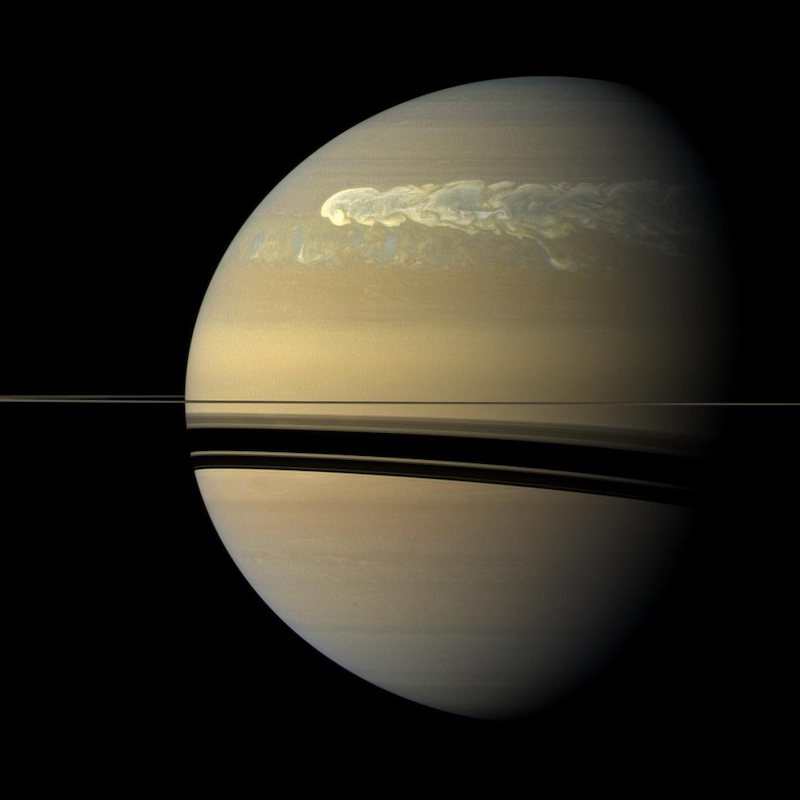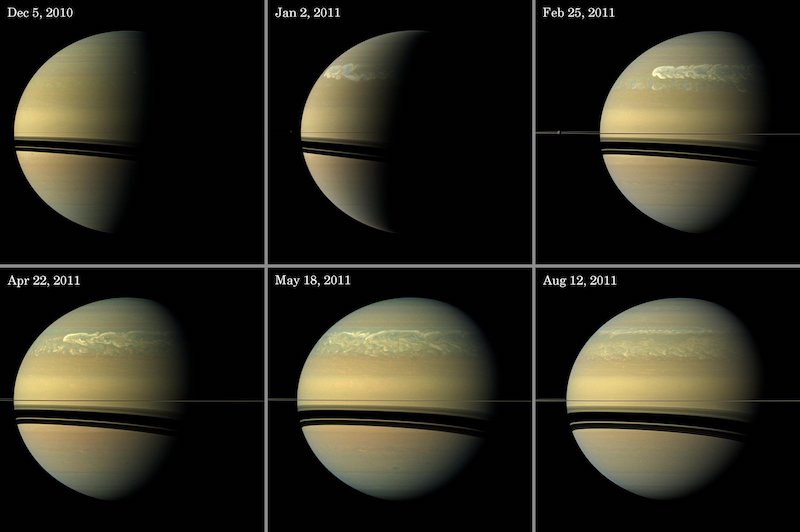Saturn is the 2nd-largest gas gian in our solar system. It’s the 6th planet outward from the sun. It’s a step beyond from Jupiter, the largest planet. And, like Jupiter with its iconic Great Red Spot – Saturn also has megastorms. They look like great white ovals on Saturn that can grow to stretch partway around the planet! On August 11, 2023, researchers said the aftereffects of the Saturn megastorms can last hundreds of years.
The last Saturn megastorm was in 2010-2011. This storm in the visible uppermost part of Saturn’s atmosphere lasted just over an earthly year.
But the storm’s deeper effects likely lasted longer, researchers say. In the new study, the researchers looked beyond Saturn’s outermost atmosphere, more deeply down into the atmosphere itself. Their analysis revealed chemical signatures in Saturn’s atmosphere of long-lived storm effects. As the paper said:
In addition to the remnant effect of the storm in 2010, we have found long-lasting signatures of all mid-latitude giant storms, a mixture of equatorial storms up to hundreds of years old …
In other words, they are seeing the traces of storms that happened hundreds of years ago. The researchers – from the University of California, Berkeley and the University of Michigan, Ann Arbor – published their peer-reviewed findings in Science Advances.

A brief history of visible Saturn storms
Like Jupiter’s Red Spot, Saturn megastorms are similar to earthly hurricanes. But they’re much larger and more powerful. Researchers have said that Saturn megastorms happen about every 29 years, when Saturn’s northern hemisphere is tilted most toward the sun in its approximate 29-year orbit. The following is a list of recorded sightings:
1876 – Observed by Asaph Hall.
1903 – Observed by Edward Barnard.
1933 – Observed by Will Hay.
1960 – Observed by J.H. Botham.
1990 – Observed by Stuart Wilber.
1994 – Studied by ground-based observers and the Hubble Space Telescope.
2006 – Observed by Erick Bondoux and Jean-Luc Dauvergne.
2010 – Photographed by Cassini space probe 2010–2011.
Scientists still aren’t sure exactly what causes these giant storms on Saturn.
How the researchers peered inside Saturn
How can these astronomers look deeply into Saturn’s atmosphere? The team used the Karl G. Jansky Very Large Array – on the Plains of San Agustin in central New Mexico, about 50 miles (80 km) west of Socorro – to study Saturn not in visible light, but via the planet’s radio emissions.
Imke de Pater of UC Berkeley said:
At radio wavelengths, we probe below the visible cloud layers on giant planets. Since chemical reactions and dynamics will alter the composition of a planet’s atmosphere, observations below these cloud layers are required to constrain the planet’s true atmospheric composition …

What the researchers saw
The researchers found something interesting: long-term disruptions of ammonia gas in Saturn’s atmosphere. The atmosphere is composed mostly of hydrogen and helium with traces of methane, water and ammonia.
The team found less ammonia than expected at mid-altitudes, below the uppermost ammonia-ice cloud layer. Conversely, they found more ammonia at lower altitudes. That enrichment of ammonia occurs about 60-100 miles (100-200 km) deeper down in the atmosphere. Why the difference?
According to the researchers, two processes play a role, precipitation and reevaporation. They transport the ammonia from the upper to lower atmosphere, and that process can last for hundreds of years at a time.
And, Imke de Pater said, knowing the true composition of Saturn’s atmosphere is necessary for building precise computer models – designed to simulate a real-world situation – helpful in explaining and predicting the behavior of the atmosphere of faraway Saturn. She added:
Radio observations help characterize dynamical, physical and chemical processes including heat transport, cloud formation and convection in the atmospheres of giant planets on both global and local scales.
Lead author Cheng Li put the finding in a larger perspective, saying in the scientists’ statement that:
Understanding the mechanisms of the largest storms in the solar system puts the theory of hurricanes into a broader cosmic context.
It challenges our current knowledge and pushes the boundaries of terrestrial meteorology.

Bottom line: A team of researchers has found that huge storms on Saturn – megastorms much larger than hurricanes on Earth – can last for hundreds of years at a time.
Source: Long-lasting, deep effect of Saturn’s giant storms











